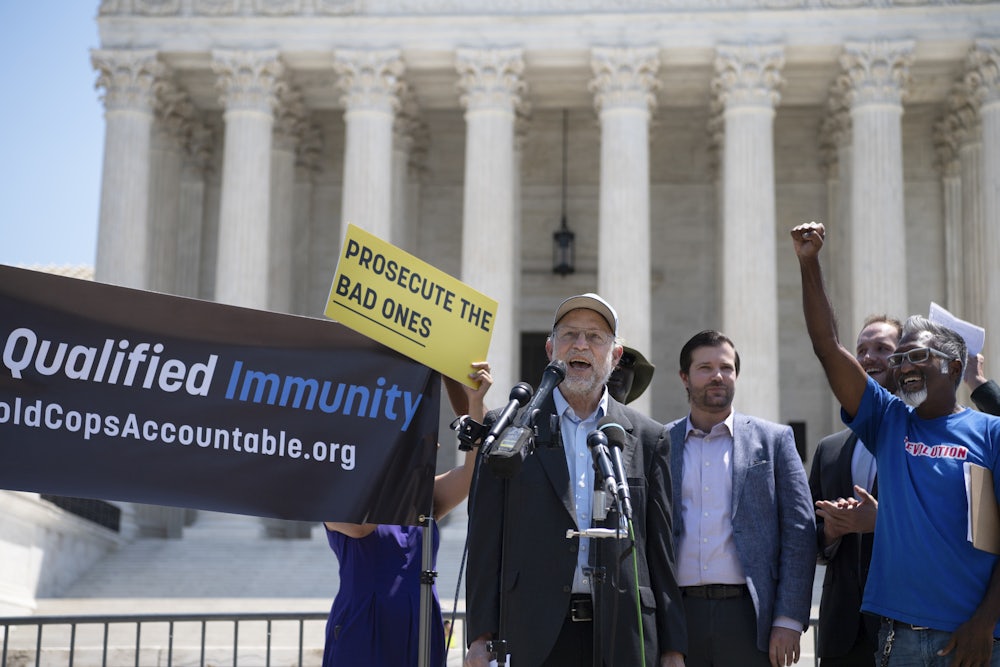What if qualified immunity isn’t real?
I don’t mean to say that qualified immunity doesn’t exist. The judicial doctrine, which allows state and local officials to be immune from federal civil rights lawsuits under certain circumstances, is regularly invoked in courtrooms across the nation. The Supreme Court has signed off on it over and over again despite widespread criticism from legal scholars, judges, and even some of the justices themselves.
But qualified immunity may be built on an even shakier foundation than many of those critics previously thought. And a new lawsuit at the high court hopes to force the justices to confront how qualified immunity may be not just misguided but also outright unlawful.
“Compelling new evidence suggests that this court’s qualified-immunity doctrine is fundamentally flawed,” Kevion Rogers, the plaintiff in the case, told the justices through his lawyers in a petition for review filed last month. “This issue impedes recovery for thousands of litigants every year, disproportionately affects the disposition of federal law, and will raise profound and troubling questions about the rule of law in this nation until this court resolves this question.”
The case, Rogers v. Jarrett, involves a model prison inmate in Texas who was injured while in the state’s custody. Rogers enjoyed a rare degree of autonomy from prison officials due to his long track record of good behavior, including the ability to work unsupervised. One of the jobs he was allowed to perform was taking care of hogs in the prison’s hog barns.
According to legal filings, Rogers went into a barn one day to care for some piglets. After he entered the barn, part of its roof collapsed and struck him on the head, knocking him unconscious. Another prisoner found Rogers, woke him, and brought him to Jeffrey Jarrett, a prison agricultural specialist. Rogers asked to go to the prison infirmary, but Jarrett rebuffed him because he thought Rogers appeared to be uninjured.
When Rogers tried to continue his workload that day, he reportedly began to drift in and out of consciousness and was clearly unwell. Other prisoners summoned prison officials, who dismissed their concerns and directed Rogers to lie down in his bunk. While en route to his dormitory, Rogers collapsed and his condition grew worse.
“By the time Rogers arrived at the dormitory, ‘he was wheezing, he had mucus draining, his face was bruising, and his eye and head were swelling,’” his lawyers told the court in their petition for review, quoting from lower court findings. “He eventually collapsed, began to ‘seize violently, began vomiting, and lost consciousness.’ Three and a half hours after Rogers first asked to be taken to the infirmary, prison officials finally radioed for medical assistance. Rogers had to be airlifted to a nearby hospital, where he was diagnosed with a traumatic brain injury.”
Rogers later sued Jarrett and other prison officials after he recovered, alleging that they had been “deliberately indifferent” to his health by denying him medical treatment in violation of the Eighth Amendment, which governs prison care. He brought his lawsuit in federal court through Section 1983, the nation’s flagship civil rights tort. It allows people whose federal constitutional rights are violated by state and local officials to sue those officials in federal court.
The provision comes from Civil Rights Act of 1871, also known as the Enforcement Act and the Ku Klux Klan Act. Radical Republicans in Congress and President Ulysses S. Grant pushed it through at the height of Reconstruction to strengthen protections for recently freed Black Americans living in the South. Section 1983 is most often associated with lawsuits over policing tactics and prison conditions since those interactions are far more likely to involve a person’s constitutional rights than, say, getting your driver’s license renewed at the DMV. But it can apply to all sorts of state and local officials, making it a valuable tool for Americans to vindicate their rights in court.
In response to Rogers’s lawsuit, the prison officials disputed the facts of the case and also invoked qualified immunity for their actions. As its name suggests, qualified immunity is a partial shield for state and local officials against Section 1983 claims. It falls short of the absolute immunity enjoyed by judges, prosecutors, and lawmakers for their official duties. But it can still be a potent barrier against lawsuits. An investigation by Reuters in 2020 found that courts were increasingly likely to use it to defeat excessive force claims against police officers.
Under the Supreme Court’s precedents, qualified immunity kicks in when a state or local official’s conduct does not violate “clearly established law” at the time of the violation. A federal district court ruled in favor of the prison officials in Rogers’s case and held that their conduct did not meet that threshold. The Fifth Circuit Court of Appeals upheld that decision in a March ruling.
“What happened to Rogers was unfortunate,” the panel concluded. “Maybe it was negligent. But was it the product of deliberate indifference? Not on this record. And even if it were, these officials did not violate clearly established law on these facts.”
But one of the Fifth Circuit panel’s three members, Judge Don Willett, wrote a separate concurring opinion. He explained that he agreed with his colleagues as a matter of precedent. He then took aim more broadly at qualified immunity, pointing to recent scholarship that cast serious doubt on its lawfulness and its historical basis.
“For more than half a century, the Supreme Court has claimed that (1) certain common-law immunities existed when Section 1983 was enacted in 1871, and (2) ‘no evidence’ suggests that Congress meant to abrogate these immunities rather than incorporate them,” Willett wrote. “But what if there were such evidence?”
That evidence, he wrote, can be found in a February article published in California Law Review by Alexander Reinart, a law professor at Yeshiva University in New York. Reinart, as Willett explained, noted that the Supreme Court had consistently read Section 1983 in the U.S. Code to not exclude so-called “common-law immunities,” which it then revived in the form of qualified immunity. But that reading was flatly contradicted by the text of Section 1983 itself when enacted in 1871.
“In between the words ‘shall’ and ‘be liable,’ the statute contained the following clause: ‘any such law, statute, ordinance, regulation, custom, or usage of the State to the contrary notwithstanding,’” Reinart explained. “And it is a fair inference that this clause meant to encompass state common law principles.”
How had the courts missed this part of the text over the last 150 years? It was not removed by Congress itself in subsequent legislation. The answer lies in a scrivener’s error. The United States Code is, technically speaking, not actually the law: It is merely a compilation of the laws enacted by Congress that is presented in a more readable and usable format. When it was first compiled almost a century ago, Reinart noted, it drew upon an earlier official attempt at codification known as the Revised Statutes of the United States, which were published in 1874.
The Revised Statute’s first edition was somewhat notorious for its errors, which prompted repeated updates and eventually a wholesale replacement. “Although the Revised Statutes were supplemented and corrected over time until the first United States Code was published in 1926, the Reviser’s error in omitting the Notwithstanding Clause from the reported version of the Civil Rights Act of 1871 was never corrected,” Reinhart noted.
This is the civil rights lawyer’s equivalent of double-checking the stone tablets that Moses brought down from Mount Sinai and finding that one actually says, “Thou shalt commit adultery.” Reinart’s discovery—and he does appear to be the first person to discover this—was a sensational find when his paper was published earlier this spring, even garnering coverage in The New York Times. The missing text upends the origin story for qualified immunity as a doctrine and indicates that it may be fundamentally flawed.
“These are game-changing arguments, particularly in this text-centric judicial era when jurists profess unswerving fidelity to the words Congress chose,” Willett wrote in his concurring opinion. “Professor Reinert’s scholarship supercharges the critique that modern immunity jurisprudence is not just atextual but countertextual. That is, the doctrine does not merely complement the text—it brazenly contradicts it.”
Willett noted that, as a lower court judge, he was obligated to follow the high court’s precedents in this matter, however questionable they may be. But he also sent up a signal flare of sorts to formally alert the Supreme Court to its existence. “Only that Court can definitively grapple with Section 1983’s enacted text and decide whether it means what it says—and what, if anything, that means for Section 1983 immunity jurisprudence,” he wrote.
The court scheduled Rogers’s petition for consideration at its September 26 conference, which it holds at the end of every summer in preparation for the upcoming term. It’s unclear whether it’s interested in a wholesale rethinking of qualified immunity: The court has allowed the doctrine to expand largely unchecked in recent years, and the state of Texas is apparently so confident in victory that it waived its right to file a reply brief earlier this month. Even if the court does not address this question in Rogers’s case, however, it is hard to believe it can run from it forever.










